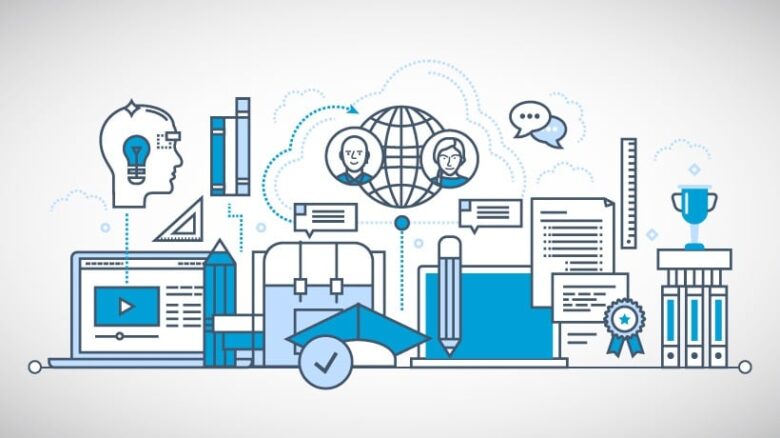Today, employee engagement, developing talent, and skill gap bridging are all critical. There are numerous acronyms to remember.
The terms “virtual learning environment” and “learning management system” are commonly used interchangeably.
In this article, we’ll go over the functionalities of both LMS and VLE and the similarities and differences between the two types of learning systems. We will also discuss how you can choose the best learning platform for your organization.
Learning Management System VS Virtual Learning Environment
Learning Management System
An LMS is a kind of software that allows companies to efficiently and quickly develop, manage, and deliver training courses, modules, and other training materials to their employees. Whether you have a small or large workforce, an LMS like Trainual makes training your employees a breeze. It also helps to grow organizations by creating effective training materials and enabling the automation of processes and giving learners more control. Trainual reviews show that the application performs well for organizations that use it for workforce development.
Characteristics Of LMS

Source: eleapsoftware.com
An LMS aids in the development of new and existing employees by providing a place for your company to store, modify, and manage training content. It enables employees to consume content, complete courses, and communicate with each other in one centralized location. An advanced LMS has the following characteristics:
Personalization
Your workers have different learning abilities, styles, and training requirements. Your virtual eLearning system should meet these requirements by offering personalized training programs that provide the most efficient learning experience for every user and role type.
Efficient Adaptation And Management
The environment in which your company operates is constantly changing. You’ll need an LMS that can evolve with it. With the aid of a modern LMS, you can efficiently plan, oversee, and upgrade training as necessary.
Progress Monitoring
An LMS allows you to record and monitor your workers’ progress, identify their strong points and evaluate their weak points as a manager or team leader, allowing you to adjust your training style accordingly.
Microlearning With Multimedia Capabilities
People learn and retain information more effectively when it is presented in bite-sized chunks. An effective LMS enables you to incorporate audio, video, quizzes, and games into your content, making it interactive, engaging, and entertaining.
Engagement Tools

Source: talentlms.com
An LMS can allow for engagement between instructors and learners through the use of chat rooms, forums, polls, and surveys which enhances collaborative learning experiences within the course.
Mobile Learning
As well as being accessible on desktop devices; modern Learning Management Systems usually come with apps that enable users to access content on their mobile phones or other mobile devices with ease providing them with ultimate flexibility to learn when they want and where they want.
Virtual Learning Environment
A virtual learning environment is a collaborative platform that allows instructors and learners to train and learn from anywhere. Instructors and learners can use VLE software platforms to create, upload, and share resources such as assessments, activities, and personal interactions. VLE is becoming increasingly popular among organizations because they make learning enjoyable and accessible anytime from almost anywhere in any location.
Characteristics Of VLE
Due to a virtual learning environment, instructors can deliver an engaging learning experience to their learners regardless of location. When you use a VLE, you’re essentially requesting virtual assistance and remote support.
Personalization Of The User Experience
VLE enables content to be customized based on how learners learn and progress.
Data Monitoring, Reporting, And Analysis

Source: elearningindustry.com
Instructors can monitor their learners’ progress, evaluate their learning abilities, and assess the effectiveness of course materials. Instructors can also view their learners’ grades and progress in the courses.
Adaptability Testing
Instructors and learners can create and submit tests when they are ready to perform their best, optimizing course results and satisfaction.
Increased collaboration between students and teachers
VLEs provide an interactive platform allowing in-depth communication between those involved in the learning process. This can include notifications, automatic grading updates, and feedback along with instant audio or video chat capabilities.
Automated grading
A VLE provides automated grading capabilities using different algorithms that generate grades based on criteria set by instructors. This eliminates the need for manual data entry while drastically speeding up time to grade completion without losing accuracy or consistency across performance levels.
Greater access to learning materials
With a VLE, students have easier access to course-related materials as well as extra study resources such as PDFs, news articles, or media links provided by their instructor. As well as this, learners can also upload their own media files which can later be accessed from any device connected to the internet; be it from home or during class sessions.
Easier course management between institutions

Source: elearningindustry.com
Many institutions use different management systems from one another; yet when using a VLE it is possible for educational establishments to connect through secure systems across multiple locations at once with no compatibility issues whatsoever – even if they host courses from different educational providers! This feature gives teachers improved control whilst providing flexible management solutions tailored specifically toward their institution’s needs.
LMS Vs. VLE: What Is The Difference?
An LMS (Learning Management System) and a VLE (Virtual Learning Environment) have many similarities. Both systems are used to provide an online learning experience, allowing students to access course content, complete assignments, view grades, and communicate with instructors and other students. Additionally, both systems feature user-friendly interfaces allowing users to easily navigate the course content and organize materials by type or topic.
Though both terms describe similar methods of organization, there is a key distinction between the two. An LMS is a software application that provides specialized tools for managing instructional programs while a VLE focuses more on creating personalized learning experiences through special media such as videos or interactive programs.
The primary goal of an LMS is to use technology tools to streamline course materials management and distribution while the primary purpose of a VLE is to create virtual learning experiences that engage learners in dynamic activities. Whereas an LMS can be used in any classroom setting whether face-to-face or online, VLEs are specifically tailored for virtual instruction environments with specific features for engaging learners remotely.
In very basic terms, an LMS helps teachers manage courses while a VLE provides students with learning experiences built around technology tools like videos or polls instead of traditional lectures or textbooks.

Source: edtick.com
If you’re an organization looking for the most effective way to train employees in a remote setting, you should consider investing in an LMS. An LMS is intended to assist employees and organizations in accomplishing professional goals in the workplace. In contrast, VLE software platforms are intended to assist learners in maximizing learning and achieving learning goals.
They are both virtual eLearning systems that provide people with remotely accessible content. They make learning simple, enjoyable, and engaging. In-depth information analysis and reporting are also possible with these two learning systems.
Conclusion
LMS and VLE allow you to run online courses, which is all that matters. An LMS is the best option if you are running business training. If your organization is focused on learning, you should explore a VLE further. Considering which tool will help them improve their results without interfering with their operations, organizations should make wise decisions between the two.




